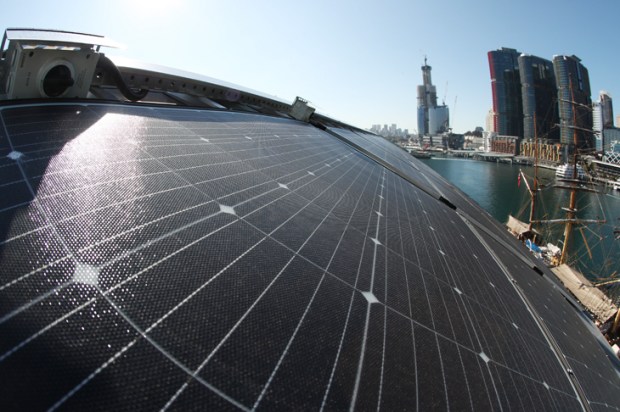As climate catastrophist world leaders busily bless the latest revised version of holy writ from the Intergovernmental Panel on Climate Change in preparation for Glasgow’s November UN climate exercise in communal economic self-flagellation, some dissident voices have suggested there is a better way to deal with what they nevertheless acknowledge to be the very real problem of global warming. Endorsed by the Australian government in a widely unnoticed dot-point in May’s federal Budget and even given faint praise in modest mentions by the IPCC itself, a campaign to enhance the significant capacity of the soil to act as a carbon sink has a particular relevance to Australia.
Although there may be scope for some reservations about the entirety of claims by Mulloon Institute chair (and my former political colleague and friend) Gary Nairn that ‘it is possible to absorb the world’s annual anthropogenic emissions in our soils’, there is no doubt about the science that soil plays a role (understated in the latest catastrophe-oriented IPCC report) in reducing the impact of climate change through the natural cycle of soil carbon sequestration – and in particular by the land rehydration techniques employed by Mulloon in the NSW Southern Tablelands in conjunction with the government’s National Landcare Program and as part of the UN’s Sustainable Development Solutions Network.
Critical of IPCC’s reliance on cutting emissions as the only recommended way to deal with climate change, Nairn points to other, simpler solutions: ‘soil contains two to three times more carbon than the atmosphere…. The long-term removal, capture or sequestration in soil of carbon dioxide from the atmosphere, helps slow or reverses atmospheric CO2 pollution’. With the IPCC forecasting a future of less rain overall but more intensive events, risking flooding and erosion, Nairn’s view that ‘the least expensive and most practical action that will quickly get results, including a return on investment, is fixing and rehydrating our degraded landscapes’, has the backing of Prime Minister Morrison. When Energy Minister Angus Taylor announced the May budget’s $37 million funding of National Soil Innovation (included in the budget’s $233 million towards improving farming productivity, profitability and participation in the Emissions Reduction Fund), Taylor said the fund would support the development of technologies to reduce the measurement costs involved in ‘unlocking the untapped potential of our soils in line with our approach to reducing emissions by innovation not elimination’.
This cause was taken up earlier this year by the Menzies Research Centre’s James Mathias in the Daily Telegraph with the claim that ‘Increasing soil organic carbon is the single most useful step we can take to remove excessive carbon dioxide from the atmosphere. By improving the way we farm, agriculture can become a net consumer of atmospheric carbon. Since Australian farming soils in aggregate are low by world standards, the potential to absorb carbon and turn it into productive use is huge. The benefits of soil carbon, however, go further than sequestration. Even without the imperative to restore the carbon balance, richer soils are more productive and require fewer inputs.
Australia is not alone in looking to better ways of dealing with CO2. In the US, the ultra-green Union of Concerned Scientists last month described the management of soil carbon as ‘an important tool in battling the climate crisis. By adopting healthy soil practices that keep carbon in soil and sequester carbon for the long term, farmers can contribute to climate change mitigation and adaptation. Such practices can boost resilience to increasingly extreme droughts and floods, reduce air and water pollution, and help farmers and their communities to thrive’.
While still focussing overwhelmingly on the negative impact on the land (floods, fire and famine) of its forecast human-emissions-caused global warming than on the positive prospects of land-use changes to assist the removal of greenhouse gasses from the atmosphere, the IPCC has nevertheless become more aware of the potential of land carbon sinks – and acknowledges that biological methods of increasing land carbon storage also enhance primary productivity. But in the IPCC’s current ‘Advice to Policymakers’ there are no policy proposals, no urgent campaign to turn land sinks into a positive weapon, even though it accepts that there is a potential to remove CO2 from the atmosphere and durably store it in reservoirs. It projects that higher CO2 emissions will result in natural land carbon sinks taking up, in absolute terms, progressively larger amounts of CO2. However, the share of emissions absorbed by land is projected to decline with increasing cumulative CO2 emissions, resulting in a higher proportion of emitted CO2 remaining in the atmosphere.
The IPCC reckons that two-thirds of the estimated carbon lost from the soil as a result of human agriculture over 12,000 years is recoverable with best management practices. ‘These may be applied to the restoration of marginal or degraded land but may also be used in traditional agricultural lands’. But while restoration of degraded forests and non-forest ecosystems can play a large role in carbon sequestration, the IPCC warns against afforestation of native grasslands, savannas, and open-canopy woodlands that lead to the undesirable loss of unique natural ecosystems with rich biodiversity, carbon storage and other ecosystem benefits. All this endorses much of the Mulloon approach, with its rehydration focus being reinforced by the IPCC’s satellite observation that links lower global-scale terrestrial water storage with a lower global net land CO2 sink.
But there remains a gap between many of the IPCC’s conclusions and hard evidence to support them. As the American Enterprise Institute conservative think-tank opined last month, ‘it is important to recognise that the assumption of many politicians, environmental groups, and no small number of scientist-activists — that humans are the single most significant cause of climate change — is simply unsupported by the available science….Public discussion of the climate crisis consistently ignores the very real possibility that the small amount of warming that will likely occur might yield noteworthy benefits….[such as] a substantial (CO2-induced) greening of the earth over the past 35 years. Though there will likely be some negative consequences of a warming planet, there will likely be positive effects as well’. So why no public IPCC campaign for world leaders to prioritise land carbon sinks, with their immediate and diverse benefits, as a less economically-destructive alternative? The suspicion is that the catastrophists at the IPCC won’t abide anything that reduces the alleged urgency of their emissions reduction mantra. As the AEI says, ‘Instead of merely dismissing the faux science that lends support to climate alarmism as a “hoax,” conservatives must do more to engage with and reclaim the growing body of scientific evidence that supports their climate-change realism’.
Got something to add? Join the discussion and comment below.
Get 10 issues for just $10
Subscribe to The Spectator Australia today for the next 10 magazine issues, plus full online access, for just $10.
You might disagree with half of it, but you’ll enjoy reading all of it. Try your first month for free, then just $2 a week for the remainder of your first year.














Comments
Don't miss out
Join the conversation with other Spectator Australia readers. Subscribe to leave a comment.
SUBSCRIBEAlready a subscriber? Log in